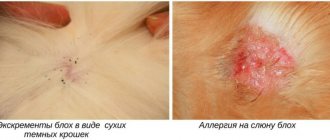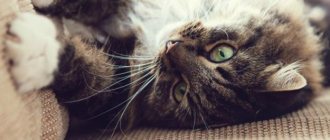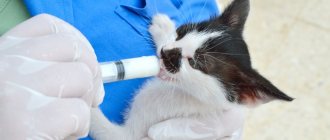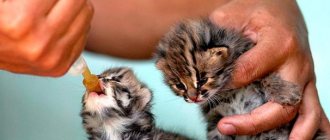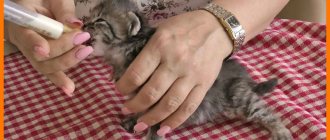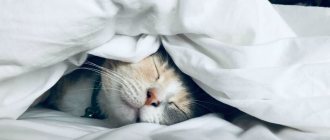Signs of a kitten having fleas
You can assume that a kitten has fleas if you find the baby on the street or if his mother has these insects. Pests cannot appear if the animals do not leave the house and do not come into contact with other cats, undergo preventive treatment and live in good sanitary conditions.
Signs of a kitten having fleas
Outwardly, a kitten may look absolutely healthy, so the presence of insects in its fur can only be determined upon examination. To do this, spread the fur at the withers so that the skin is visible. Signs of flea infestation:
- Black fragments (insect excrement) are visible;
- White specks (parasite eggs) were found;
- There are inflammatory processes on the skin, wounds, bite marks;
- The insects themselves are noticed (fleas have a black or dark brown, oblong body).
You can also suspect an infection based on your pet’s behavior. If he often itches his paw and suddenly starts and stops the process, he may have fleas. This behavior is caused by painful insect bites. In addition, symptoms such as lethargy and poor appetite may be present.
Article on the topic: How to find out if a cat has fleas
Danger of flea infestation
Fleas are blood-sucking parasites that cause a lot of trouble for pets and their owners. Insect infestation is dangerous even for healthy adult animals, let alone small kittens.
Life activity of fleas in a kitten:
- provokes severe itching and irritation of delicate skin;
- lead to local and widespread hair loss;
- causes allergic dermatitis in kittens (skin reactions to insect saliva and feces);
- causes anemia;
- poses a risk of helminth infection.
Even a domestic cat that never goes outside can be attacked by fleas, because these parasites are able to travel long distances in search of a new victim. The owner, without knowing it, can bring eggs and insect larvae into the house along with outdoor shoes and clothing.
One flea caught on an animal can lay up to 300 eggs in two weeks, and if the owner misses this moment, a cat infected during pregnancy and lactation will certainly pass on the parasites to all of its offspring. A weak newborn kitten infected with fleas may die if there is no quick and qualified human assistance.
Features of flea removal in kittens
How to remove fleas from a kitten at home depends on the age of the baby and the number of insects. Up to 3-4 months, kittens have a very weak immune system; the use of chemicals can cause more harm to the pet’s health than the presence of parasites. Therefore, sometimes it is worth holding off on removal, especially if there are very few insects on the fur.
Only home methods are suitable for treating newborn kittens under one month of age. From 2-3 months, some chemicals can be used.
If the baby has not yet been weaned from its mother, all substances applied to its fur will enter the digestive system of the cat, and then the kitten during feeding through milk.
The use of insecticidal preparations based on poisons is permissible in kittens only after reaching 6 months of age. They are applied exclusively to the withers - a place that the pet cannot reach when licking the fur.
It is believed that a cat can rid a kitten of fleas while licking, but no matter how much she chases parasites through the baby’s fur, she cannot cope with this scourge without your help.
For the flea removal process to be effective, it is necessary to treat all cats in the house at the same time. It is advisable to carry out a general cleaning and eradicate insects in carpets, upholstered furniture, along baseboards and in pets’ sleeping areas.
Please note that the use of some products is permissible only after a certain period of time after vaccination of the animal. Strong drugs should also not be used if your pet is sick.
Who are fleas
A flea is a very small insect that feeds on the blood of domestic animals. They have a flat body and small but tenacious paws, thanks to which they move quite quickly around the body of even long-haired cats.
These bloodsuckers are equipped with a shell, which makes it impossible to crush them, for example with your fingers. Like a number of other harmful insects, fleas belong to the category of carriers of various infections.
These are very tenacious individuals, capable of surviving without a donor for a long time without dying. As a rule, fleas are not particularly harmful to humans, but they do not bode well for kittens.
It is not always possible to immediately identify fleas in domestic kittens - they are mainly noticeable when there are already a lot of them and characteristic signs appear.
Traditional methods
You can get rid of fleas on a kitten at home without the use of special chemicals. This is especially true if the baby is less than 2 months old. Traditional methods are gentle and harmless, but sometimes tedious and not effective enough. But if you have no choice, it's worth trying them. How to remove fleas from a kitten using traditional methods: manually or using natural remedies.
Mechanical removal
By rights, the safest method of getting rid of fleas is mechanical, which allows you to remove insects even from newborn kittens. At the same time, it is the most labor-intensive and time-consuming, since it is not possible to quickly get rid of fleas by combing due to the presence of numerous clutches of eggs.
To carry out the procedure, you will need a hard plastic comb with frequent rounded teeth and a white sheet of paper. Combing fleas should begin from the back, gradually moving to the abdomen and paws. It is not recommended to manipulate the pet's head - you can injure the kitten's ears, nose and eyes. Any fleas on the paper should be immediately crushed or thrown into a container of water. The processing comb also needs to be periodically cleaned of accumulations of insects and hair.
You need to carry out the procedure twice a day until the fleas disappear. One combing session should take about 10 minutes on average. As a rule, it takes 1 month to solve the problem. Afterwards, it is necessary to check the fur for several weeks, since new individuals could emerge from the remaining eggs.
Bathing
Plain water will not get rid of fleas. But if you add salt, tansy or wormwood to the bath, the insects will begin to disappear.
Salt bath. Add table salt to warm water at the rate of 1 tbsp. 200 ml, dissolve. Place your pet in the solution for 10 minutes. Then pat the fur dry with a towel and comb out with a comb. Repeat the procedure every week.
A decoction of wormwood or tansy. Brew the chopped herb in boiling water (1 tablespoon per glass). Prepare a warm bath and pour in the infusion. Keep your pet in the solution for several minutes and dry the fur well. The procedure can be carried out several times a week.
Important! When bathing, be careful not to get water into your pet's ears, nose or eyes!
Tar soap
This flea remedy for kittens is completely safe and quite effective. The soap needs to be turned into thick foam. To make the process easier, you can grate the piece and dissolve it in warm water. The foam should be rubbed into the pet’s fur and rinsed off after a few minutes. To remove dead insects, you can comb the fur after drying.
Bathing and mechanical methods of control
Bathing, as a method of combating fleas in a pregnant cat, can only be suitable if the animal is accustomed to water procedures, otherwise it will cause stress and harm the mother and offspring. If shampoo treatment has been used previously, then this method is quite suitable.
Bathing
Rules for treating flea shampoo:
- For swimming you need warm water, 37 – 39 0C.
- The bottom of the sink, bathtub or basin should be covered with a towel, the cat will be able to cling to it with its claws, and it will be calmer.
- You need to prepare several terry towels that absorb moisture in advance.
- The shampoo does not need to be used in its pure form, but rather diluted in a small amount of water according to the instructions.
- When the fur gets wet, fleas can rush to where it is dry, that is, to the head, which should not be wet. To prevent this, you need to first soap your neck, this will create a protective barrier.
- The foam should remain on the fur for 5 - 7 minutes so that the animal does not break out, you can wrap it in a towel and carry it in your arms.
- The shampoo must be thoroughly rinsed with running water.
Pet owners are wondering whether it is possible to treat a nursing cat with flea shampoo. The answer is no, because particles of the insecticidal agent contained in the shampoo remain on the fur. Kittens, while feeding, are in close contact with their mother, so the toxic substance can harm them.
A safe way to combat blood-sucking insects is to comb out with a fine comb. This is a labor-intensive and time-consuming process, but it will help remove fleas from a pregnant and lactating cat.
Special chemicals
If a kitten is older than 2 months and the baby has already been weaned from its mother, some chemicals can be used. Before using them, it is important to assess the kitten’s health; if it is weakened, you should choose the more gentle methods described above, or consult a veterinarian. The first time you need to use the product in a small volume to assess the reaction of your pet’s body.
Shampoos
The most affordable, popular and relatively harmless means for getting rid of fleas at home are shampoos based on plant extracts, such as celandine, or synthetic toxic substances.
Important! The packaging of the shampoo should indicate the age at which it should be used! Make sure this product can be used for your pet.
The kitten must be treated with the drug according to the instructions on the package, then thoroughly rinse off the remaining shampoo with warm water, dry the fur and comb out dead fleas and their eggs. Usually only 2-3 baths are enough to completely remove insects.
Collars
These products are designed to protect the kitten from re-infection with fleas, but they are unlikely to be able to exterminate the insects. Collars can be used from 6-8 months of age.
Features of using flea collars:
- They can rub the delicate skin on the kitten’s neck;
- In some cases they cause allergies and irritation;
- The kitten will try to remove the collar and may damage the integrity of the skin with its claws;
- The baby will experience discomfort from the uncomfortable thing.
Flea remedies for kittens
It is advisable to use collars if there are many pets in the house and some of them have fleas, as well as if a nursing cat is infected. It is worth using them for some time after the insects have hatched in order to prevent re-infection by individuals hatched from laid eggs.
Article on the topic: Flea collar for cats
How to detect parasites?
It is not difficult to understand that a kitten has fleas. The baby's behavior changes, he becomes restless, fearful, periodically suddenly begins to itch, and then also suddenly stops doing so. Over time, the baby loses interest in food, eats little, and loses weight.
You can detect bloodsuckers by examining the kitten. You need to spread the fur so that the skin is visible. It is best to do this in the area of the withers or upper back, since fleas first settle there. Depending on the intensity of the infection, you can either find traces of the vital activity of insects or detect them themselves.
When can medications be dangerous for kittens?
When starting the procedure, you should clearly understand due to what properties a particular medicine will be effective. Most often, they contain insecticides that are low-toxic for people and adults, but harmful to kittens.
Pay attention to the composition of the products. If you find Malathion, Dichlorvos, Permethrin and its derivatives in the composition, you should not use them before six months of age.
Another important point. Only by weaning it from its mother can a kitten be treated for infection. Cats have a peculiarity: they lick their babies while they feed on their mother's milk. If a cat licks some of the toxic substances from the kitten's fur, they will pass into the milk.
In general, you should forget about strong insecticidal drugs if the kitten is under a month old. If there are a lot of fleas, separate him from his mother for a while while you perform pest control.
If there are few fleas and the kitten is not yet a month old, you need to carry out preventive measures, and after they grow up a little, start removing them thoroughly, using the same insecticidal agents.
Safe pest control products
One of the important components of cat treatment is how safe the chosen method is for the pet’s health. To avoid harming your cat, you can opt for natural and safe products.
Combing out fleas
Short-haired cats can be combed with a fine-tooth comb. Brush the coat with a fine-tooth comb and then with a fine-tooth comb. Shake parasites from combs into a bowl of soapy water. In this way, you can remove some fleas from the skin of animals, but this will not completely solve the problem.
Herbal treatment and eco-collar against fleas
Some herbs, such as chamomile, rosemary, wormwood and wormwood, geranium and tansy, are considered natural remedies for fighting parasites. There are three ways to herbally treat an animal:
- Herbal rub. Soak a cotton swab in the herbal infusion and wipe the cat's fur.
- Herbal shower. Rinse your cat's fur with the herbal infusion and let it dry.
- Herbal powder. Sprinkle the powder on the areas where insects are most concentrated on the animal’s body.
To make your own eco-collar that is safe for your cat, you will need absorbent fabric. Sew a strip from it around the circumference of the animal’s neck, adding 2 cm to the length. Sew Velcro on both sides of the collar and treat the fabric with a special compound:
- 1 drop of lavender oil;
- 1 drop of thyme oil;
- 1 drop of eucalyptus oil;
- 1 drop of citronella oil;
- 5 ml alcohol;
- 10 ml jojoba oil.
Do not wring out the collar and place it on the animal's neck. After 30 days, replace the eco-collar.
Washing the bed, toys and cleaning the house
These harmful insects live not only on the animal, but also where the cat spends the most time. To kill any parasites living in your cat's bed, wash it in soapy, hot water at least once a week.
Aromatization of the room
If you have an aroma lamp, then you can scent the room. Use essential oils of lavender, thyme, rosemary, tea tree or eucalyptus.
You can also finely chop the garlic and place it on plates around the apartment. This smell will repel fleas.
If you like to grow flowers, then plant geraniums or lavender in pots.
Boosting immunity and love
Make your pet's diet balanced and add vitamins to it. The best option would be to switch to high quality food. Add brewer's yeast to your cat's diet - fleas cannot tolerate it.
Don't forget to show love and care. Give your pet attention and play with her. As a rule, happy animals do not get sick as often.
What to choose depending on the baby’s age
Treatment is carried out according to the age of the kitten. A newborn is more gentle to chemicals than a six-month-old baby. Therefore, experts always prescribe the dosage for a specific age on the packaging.
1 month
Age requires additional protection. Especially if the kitten was separated from its mother. Scratching is suitable for a newborn, and can also be washed with a gentle product. It is better to choose a natural shampoo that will help protect the kitten from insects and minimize the onslaught of fleas.
1.5 months
At this age, you can use all the methods as for a newborn. Additionally, there are sprays on the market that can be applied from 1.5 months of age.
They can only be purchased at a veterinary clinic. The hardware department of some shopping centers also offers a wide selection of flea baiting chemicals.
2 months
An infectious kitten at 2 months can already use specialized drops in addition to sprays, shampoo and combing. They can be purchased at veterinary pharmacies without a prescription.
Important! You should not wash your kitten for 4-5 months after applying the product. If this cannot be avoided, the drops are reapplied. The drops must be used strictly according to the instructions.
3 months
At 3 months, you can use all the means discussed earlier - shampoos, sprays and drops, combing (although kittens at this age can already do this on their own).
Important! Only a veterinarian or a breeder at his own discretion can determine which method is best to use. The main thing is to choose a drug based on age and weight.
Instructions: how to apply flea drops
Each package of drops contains instructions on how to give the kitten the drops. The instructions indicate indications and contraindications that must be studied first. Typically, the contraindications section indicates the minimum permissible age for processing.
The generally accepted rules for treating animals against fleas using drops include:
- The product is applied to intact, dry skin.
- Drops are applied to the back of the head or shoulder blades, so that the kitten does not reach the treated areas while washing.
- During the first hours after treatment, the kitten must be closely monitored as side effects may occur.
- If you are unable to ensure that the kitten does not lick the drops, you need to put an Elizabethan collar on it.
When treating kittens, it is not recommended to use products whose dosage is designed for large weights, for example 1 ml per 10 kg of body weight.
In addition, it is strictly not recommended to use drugs intended for dogs when treating cats.
Review of popular flea drops - application, indications and contraindications
Never believe what it says on the label! That’s right, if the drops say “for kittens,” most likely we are talking about animals older than 2–3 months. For reference, animals under 9–12 months of age are also considered kittens, so manufacturers do not lie when they place colorful labels on packages.
Important! There are no absolutely safe flea drops. Always read the instructions before use! If you have any doubts about the safety of the drug, it is better to consult a veterinarian.
Leopard
The drug differs from most drops in the number of components. The main active ingredients of Bars drops are:
- Fipronil.
- Diflubenzuron.
- Dicarboximide.
Interacting, the active substances give a relatively good result, against the background of low toxicity. Once in the body of parasites, the active substances disrupt the functioning of their nervous system, which quickly leads to paralysis, and within 2-4 hours to death. In addition, Bars drops have a detrimental effect not only on adult parasites, but also on their eggs. Simply put, drop treatment interrupts the flea reproduction cycle, and this is very important at any stage of the infestation.
Indications for use: elimination of skin parasites, including fleas, lice, lice, subcutaneous and pasture ticks in animals older than 2 months.
Contraindications to the use of Bars drops:
- Individual intolerance.
- Acute allergic reactions.
- Immunocompromised animals: dehydrated, malnourished, sick or recovering from illness.
- Carriers of a viral infection.
- Kittens under 8 weeks and cats over 12 years old.
- When treating ear mites, the use of drops in case of perforation of the eardrum is not recommended.
According to the manufacturer, the active ingredients are distributed throughout the deep layers of the skin without penetrating into the systemic bloodstream. When used externally, the drug is considered moderately toxic, but drops must be used observing all safety precautions. Upon contact with mucous membranes, the active ingredients of Bars drops cause irritation; if swallowed, the toxicity of the drug increases sharply.
The recommended dosage is as follows:
- Cats weighing up to 1 kg – 0.3 ml.
- Cats weighing 1–3 kg – 0.6 ml.
- Cats weighing more than 3 kg – 1 ml.
Important! Drops are applied only to dry, intact skin.
Celandine
According to the manufacturer, Celandine drops can be used to prevent and treat infestations of skin parasites in kittens and adult cats. The residual effect of the drug lasts up to 2 months against fleas and up to 1 month against pasture ticks.
The active ingredients of Celandine drops are:
- Fipronil.
- Permethrin.
The range of the drug is aimed at combating external parasites: fleas, lice, lice and ticks. In addition, Celandine is prescribed for the treatment of subcutaneous mites. According to the manufacturer, the composition of the drops helps to effectively fight parasites at different stages of growth (from egg to mature individual). The active ingredients of the drops disrupt nerve conduction in parasites, which leads to their paralysis and death.
Contraindications to the use of Celandine drops:
- Kittens under 8 weeks old.
- Cats over 12 years old.
- Animals suffering from liver and kidney pathologies.
- Virus carriers.
- Weakened, emaciated, dehydrated animals.
- Animals that are sick or recovering from illness.
Note! When used externally in recommended doses, the drug is classified as moderately dangerous. Upon contact with mucous membranes, the active substances cause severe irritation. When licked and swallowed, drops can lead to both local reactions (salivation, allergies) and poisoning.
The dosage of Celandine drops is calculated by the weight of the animal:
- For cats weighing up to 2 kg – 0.5 ml.
- For cats weighing over 2 kg – 1 ml.
Rules for bathing kittens
It is worth remembering that not all drugs are approved for use. Initially, the shampoo is diluted with water, and the pet’s fur is lathered with this solution. The pet should remain in this state for several minutes (see instructions). After the time has passed, the kitten should be washed with warm, but not hot water and dried. At the end of the procedure, the pet should be combed with a fine comb, which will help to finally get rid of the insects.
Choosing a specialized shampoo
When choosing a shampoo, you should consider the following characteristics of a kitten:
- Age of the kitten. Newborns are recommended a specialized product that will not damage their skin.
- The intended purpose is that if the infection is severe, then insecticides are used, and the preventive measure implies a gentle composition.
- Depending on the pet's condition - with a weakened body, anemia, pregnancy, only a gentle composition.
- Features of wool - shampoos for both long-haired and sphinxes.
- Storage period.
To correctly resolve issues related to the health of your pets, we recommend contacting a veterinary clinic.
Let's name the main brands of shampoos:
- Leopard. Used for newborns as a prophylaxis.
- BioVax. Used as a preventive measure for babies from 1 month of age. Also suitable for sick and weakened animals.
- Celandine. Used as treatment and prevention from the age of two months.
- Lugovoy. Used as treatment and prevention from 12 weeks of age.
The remaining shampoos are used for kittens from 4 months of age.
Precautions when baiting fleas with insecticides
Any insecticide can pose a health hazard. In order to avoid unpleasant consequences for the pet and the owner when using it, you must act while observing safety precautions.
For a kitten
When carrying out treatment, you need to make sure that the product does not get into your pet’s eyes, nose or mouth. It is necessary to apply the drug to get rid of fleas so that the kitten cannot lick it off. If your baby does try the medicine, you should immediately seek medical help.
For the owner
Even in the process of combing out fleas from a kitten, the owner needs to be collected and attentive, and in the process of treating the pet with insecticides, the importance of precautions will increase significantly. Basic Rules:
- apply the product with gloves and a mask, then wash your hands thoroughly;
- It is better to carry out processing in the fresh air or in a room with good ventilation;
- During the first hours after the procedure, do not pet the kitten and do not allow other pets or children near it.
If the product gets on the skin or mucous membranes, wash it off with cool water.
Symptoms of appearance
- itching, loss of appetite;
- weakness, lethargy . Usually these symptoms appear due to large blood loss due to bites;
- redness of the skin, wounds, ulcers . After the bite, an infection occurred and an inflammatory process began;
- allergic reaction.
If at least one of the listed symptoms is present, you should immediately carefully examine the baby. You can do this yourself by spreading the fur on his back or belly. The presence of small white and black grains on the body (eggs and excrement of parasites) will immediately confirm your guesses.
What is better for fleas: drops or a collar?
Let’s immediately decide what is better for fleas: drops or a collar. Misconceptions in this matter drive many owners to despair. The fact is that the collar itself is an additional preventive measure. Putting a collar on a flea-infested kitten will not get rid of parasites!
The collar is used as a measure of additional protection, not even against fleas, but against ticks. After treatment with drops, the collar serves as a means of repelling new parasites. In addition, wearing a flea collar before the recommended age can lead to stunted growth and development.
